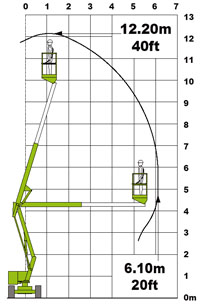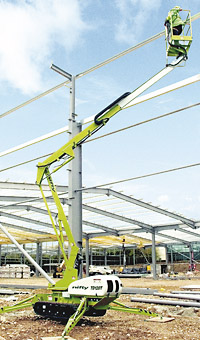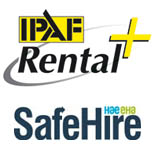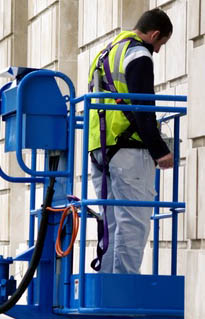Cherry Picker Safety
To comply with H&S legislation it is advisable to be properly trained. The IPAF courses for a Cherry Picker License or "ticket" are the most widely recognised qualification. Answers to What is IPAF? and More about Cherry Picker Training here
There are plenty of rules, regulations, directives, guidance and advice around to try and guide workers and management to be safe. It’s easy to lose sight of the essential aspects of safety when it’s distilled down to ticking boxes on paperwork. Let’s just look at the basic elements that make up safe working methods. These are things that really are common sense, the rest of the Health and Safety job is about recording your answers and recording that you have followed the right procedures.
 What does the working at height job involve?
What does the working at height job involve?
To start with you need to decide if a Cherry Picker is the right machine or equipment for job. As discussed earlier there might be a better solution. Always bear in mind the limitations of the machine and never force, adapt or push things past safe limits. A little extra capacity for example, platform height or reach can cover those unexpected snags where operators might otherwise decide to get “creative” on the spur of the moment.
What’s the site and working area like?
 The most obvious thing to check is the ground conditions for the Cherry Picker you want to use. A visual inspection is a good start, but there may be hidden surprises that could topple a Cherry Picker so do some testing and research. Remember even roads and concrete slabs can be poorly constructed or eroded. If the ground is OK, look up. Is there anything that could get in the way or needs to be avoided? The obvious things to look out for are power or other cables but there could be other obstacles that might interfere with the boom as it is being raised or positioned.
The most obvious thing to check is the ground conditions for the Cherry Picker you want to use. A visual inspection is a good start, but there may be hidden surprises that could topple a Cherry Picker so do some testing and research. Remember even roads and concrete slabs can be poorly constructed or eroded. If the ground is OK, look up. Is there anything that could get in the way or needs to be avoided? The obvious things to look out for are power or other cables but there could be other obstacles that might interfere with the boom as it is being raised or positioned.
In more general terms, you have to ensure you’ll have the authority you need on site to keep control of your working area. You have to be able to stop anyone else affecting your safety.
Is the Cherry Picker going to work as it should?
Any sophisticated piece of equipment including Cherry Pickers can breakdown. The only way to minimise this possibility is to make sure it is well maintained and inspected regularly. Thorough inspections should be carried out every six months by a trained a competent person. This should identify any potential problems, wear or loss of performance. The 6 month inspections are a bit like a car’s MOT, they check the current condition and highlight any issues that need addressing but things can still go wrong if the machine is not maintained or used properly.
Weekly inspections and daily checks will be recommended for each individual machine. These simple checks are intended to spot any problems that may have developed that could hinder safety or performance. If these checks are carried out then, in most circumstances, the machine will perform as expected in a safe fashion.
 The operator also needs to monitor performance and how the Cherry Picker is reacting whilst he’s using the machine. The source of any sudden or gradual changes needs investigating immediately. These inspections, checks and the required regular maintenance should never be omitted and any problems should be properly fixed before continued use. People’s lives depend upon it!
The operator also needs to monitor performance and how the Cherry Picker is reacting whilst he’s using the machine. The source of any sudden or gradual changes needs investigating immediately. These inspections, checks and the required regular maintenance should never be omitted and any problems should be properly fixed before continued use. People’s lives depend upon it!
If your hiring a Cherry Picker the IPAF RENTAL+ and HEA SAFE HIRE accreditations will be a good indicator that all the necessary inspections will have been carried out.
Does the Cherry Picker Operator know what he’s doing?
 There is no legal requirement for operators to have special qualifications to use Cherry Pickers. Site operators and employers however, have a legal responsibility to ensure the safety of employees or people working on their site. Obviously if an operator doesn't’t really know what he’s doing (isn’t competent) then accidents are more likely to happen and someone will be liable for letting the operator use that equipment.
There is no legal requirement for operators to have special qualifications to use Cherry Pickers. Site operators and employers however, have a legal responsibility to ensure the safety of employees or people working on their site. Obviously if an operator doesn't’t really know what he’s doing (isn’t competent) then accidents are more likely to happen and someone will be liable for letting the operator use that equipment.
For this reason many sites and employers will insist that operators are trained and can prove they how what they are doing. The most widely recognised qualifications are issued by IPAF (International Powered Access Federation) and qualified operators are issued with a PAL card (Powered Access Licence)
The question “Do I need a PAL card, Access License, IPAF Training to operate a Cherry Picker?” is often asked.
The simple answer is NO. It’s not illegal, however: If the Operator has a valid PAL card he’s been trained in all the operation and safety aspect of the appropriate machine type. So he should be fully aware of all the necessary steps to be taken and working practices to keep himself and those around him safe. A recognised qualification if often a requirement by major contractors and site management so that they can follow their risk assessment procedures.
Can anyone or anything else possibly interfere or go wrong?
This is where a good risk assessment procedure should be used to identify and mitigate any possible situation that could arise that may jeopardise the safety of the operation. The tenet “ Expect the unexpected” should always be employed. These are going to be site specific factors but anything that could interfere with the safety and stability of the Cherry Picker should be considered. The most unpredictable being what other people might do or cause to happen.
The safest way to mitigate the effects of other people is to make sure they are totally excluded from the working area especially if they are operating any kind of plant machinery or vehicles.
Also consider what could go wrong with the job you are up there to do. This is a particular concern if there’s a chance that anything sizeable or heavy could become unstable or move in a unpredictable fashion.
Lastly, when working outside, always keep an eye on the weather. Strong winds, gusts, rain and snow will have an effect so be vigilant.
What happens if something does goes wrong while using a Cherry Picker?
Planning what to do in advance of a problem can reduce the effects of any problems. So make sure someone is in charge of coordinating the response to any incident. This could range form calling the emergency services, administering first aid to simply re-fuelling or operating the Cherry Picker emergency back-up systems.
The above list isn’t intended to be fully comprehensive and won’t be fully applicable in all situations. Hopefully it gives you some insight to the kind of factors that do need consideration.
It is advisable and in most circumstances it is required by law to be properly trained to use this type of equipment . The IPAF courses for a Cherry Picker License or "ticket" are the most widely recognised qualification. Answers to What is IPAF? and More about Cherry Picker Training here.
Section Contents:
All about Cherry Pickers on iDoStuff (please read the notes)
What is a Cherry Picker
Types of Cherry Pickers
Cherry Picker Limitations
Cherry Picker Safety
IPAF Training for Cherry Pickers
IPAF Course Cost in Detail

